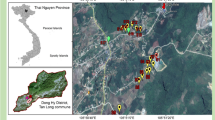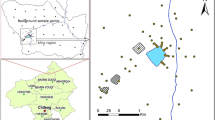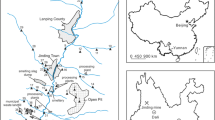Abstract
The Kouh-e Zar mining area is located in the central part of the “Khaf–Bardaskan” volcanic-plutonic zone, NE Iran. Mining activity has resulted in pollution of soil and water resources by potentially toxic elements including arsenic (As), cadmium (Cd), chromium (Cr), copper (Cu), antimony (Sb), nickel (Ni) and zinc (Zn). In this study, the major source of heavy metal pollution and elucidating the probable environmental risks associated with this area were determined by quantifying pollution in soils and water resources. Concentrations of Cd, Cr, Cu, Pb and Zn in the Kouh-e Zar mining area varied in the range of 5–470, 33–442, 25–5125, 81.15–12,096.27 and 55–4210 mg/kg, respectively. The geo-accumulation index for Cd in all samples was extremely high (Igeo > 5) and the enrichment factor also shows an extremely high amount (EF > 40), both representing evidence for highly polluted soil in the area. However, the coefficients of aqueous migration (Kx) of Cd, Cr, Cu, Pb and Zn were Kx < 0.1, so they are classified as “least mobile and inert” grade. Also, the heavy metals tend to remain in soil (solid environment). Cluster analysis (CA) determined the lithogenic origin for Zn, Cu, Cr and Cd, and the anthropogenic origin (mining activity) for Pb in the soils of the mining area. The concentrations of Cd, Cu, Pb and Zn in water are controlled by free Fe and Mn oxy-hydroxide content in the soils. Both water–rock interaction and mining activity have contributed to pollution in the area.




Similar content being viewed by others
References
Abrahim GMS, Parker RJ (2008) Assessment of heavy metal enrichment factors and the degree of contamination in marine sediments from Tamaki Estuary, Auckland, New Zealand. Environ Monit Asess 136:227–238
Behroozi A (1987) Geological map of Feyzabad 1:100000. The geological survey of Iran (In Farsi)
Bowen HJM (1979) Environmental chemistry of the elements. New York: Academic Press. ISBN: 0121204502 9780121204501
Brereton RG (2003) Data analysis for the laboratory and chemical plant. John Wiley & Sons Ltd., West Sussex
Buat-menard P, Chesselet R (1979) Variable influence of the atmospheric flux on the trace metal chemistry of oceanic suspended matter. Earth Planet Sci Lett 42:398–411
Cao HC, Luan ZQ, Wang JD, Zhang XL (2009) Potential ecological risk of cadmium, lead and arsenic in agricultural black soil in Jilin province, China. Stoch Env Res Risk A 23:57–64
Chapman HD (1965) Cation exchange capacity. In: Black CA et al (eds) Methods of soil analysis. Agronomy 9. American Society of Agronomy, Inc., Madison, pp 891–901
Chopin E, Alloway B (2007) Distribution and mobility of trace elements in soils and vegetation around the mining and smelting areas of Tharsis, Riotinto and Huelva, Iberian Pyrite Belt, SW Spain. Water Air Soil Pollut 182:245–261
Dube A, Zbytniewski R, Kowalkowski T, Cukrowska E, Buszewski B (2001) Adsorption and migration of heavy metals in soil. Pol J Environ Stud 10(1):1–10
Hakanson L (1980) Ecological risk index for aquatic pollution control. A sedimentological approach. Water Res 14:975–1001
Idris AM, Eltayeb MAH, Potgieter-vermaak SS, Grieken RV, Potgieter JH (2007) Assessment of heavy metals pollution in Sudanese Harbours along the Red Sea coast. Microchem J 87:104–112
Loska K, Wiechula D, Korus I (2004) Metal contamination of farming soils affected by industry. Environ Int 30:159–165
Mazloumi AR (2008) Mineralogy, geochemistry and study of gold &tungsten mineralization on Kuh e-Zar area, Torbat-e-Haydaryeh region. PhD thesis, university of Shahid Beheshti, Iran, pp 2–25
Mehra, O. P. and Jackson, M. L. (2013). Iron oxide removal from soils and clays by a dithionite-citrate system buffered with sodium bicarbonate. Proceedings of the 7th National Conference on Clays and Clay Minerals, pp. 317–327
Mico C, Recatala L, Peris M, Sanchez J (2006) Assessing heavy metal sources in agricultural soils of an European Mediterranean area by multivariate analysis. Chemosphere 65:863–872
Muller G (1969) Index of geoaccumulation in sediments of the Rhine River. GeoJournal 2:108–118
National Academy of Sciences (NAS) (1978) An assessment of mercury in the environment. National Academy of Sciences, National Research Council, Washington, DC
Navarro M, Perez-Sirvent C, Martinez-Sanchez M, Vidal J, Tovar P, Bech J (2008) Abandoned mine sites as a source of contamination by heavy metals: a case study in a semi-arid zone. J Geochem Explor 96:183–193
Nelson DW, Sommers LE (1982) Total carbon, organic carbon and organic matter. In: Page AL, Miller RH, Keeney DR (eds) Methods of soil analysis, part 2, chemical and microbiological properties. Agronomy monograph no. 9, 2nd edn. ASA, Madison, pp 539–577
Pais I, Jones JB (1997) The handbook of trace element. CRC Press, Boca Raton 240 pp
Pansu M, Gautheyrou J (2006) Hand book of soil analysis. Springer-Verlag Berlin Hei-delberg, 1-993
Pauwels JM, Van Rust E, Verloo M, Mvondo ZEA (1992) Manual of soil laboratory analytical methods of soil and plants, 28th ed. AGCD, Brussels
Perelman AL (1967) Geochemistry of epigenesis. Plenum Press, New York, p 266
Posthuma L, Eijsackers HJP, Koelmans AA (2008) Ecological effects of diffuse mixed pollution are site-specific and require higher-tier risk assessment to improve site management decisions: a discussion paper. Sci Total Environ 406:503–517
Rafiei B, Bakhtiari Nejad M, Hashemi M, Khodaei AS (2010) Distribution of heavy metals around the Dashkasan Au Mine. Int J Environ Res 4(4):647–654 ISSN: 1735-6865
Razo I, Carrizales L, Castro J, Diaz-Barriga F, Monroy M (2004) Arsenic and heavy metal pollution of soil, water and sediments in a semi-arid climate mining area in Mexico. Water Air Soil Pollut 152:129–152
Resmi G, Thampi SG, Chandrakaran S (2010) Brevundimonas vesicularis: a novel bio-sorbent for removal of lead from wastewater. Int J Environ Res 4(2):281–288
Segura R, Arancibia V, Zuniga MC, Pasten P (2006) Distribution of copper, zinc, lead and cadmium concentrations in stream sediments from the MapochoRiver in Santiago, Chile. J Geochem Explor 91:71–80
Stoffers P, Glasby GP, Wilson CJ, Davis KR, Watter P (1986) Heavy metal pollution in Wellington Harbour. NZ J Mar Freshw Res 20:495–512
Sutherland RA (2000) Bed sediment-associated trace metals in an urban stream, Oahu, Hawaii. Environ Geol 39:611–626
Taheri M, Mehrzad J, Mahmudy Gharaie MH, Afshari R, Dadsetan A, Hami S (2016) High soil and groundwater arsenic levels induce high body arsenic loads, health risk and potential anemia for inhabitants of northeastern Iran. Environ Geochem Health 38:469–482
Tahmasebi P, Mahmudy Gharaie MH, Ghasemzadeh F, Karimi Karouyeh A (2015) A survey on heavy metals pollution in water resources of Kouhe Zar Mining area (The West of Torbat Heydarieh, Iran). J Biodivers Environ Sci 7(3):244–253
Tamasi G, Cini R (2004) Heavy metals in drinking waters from mount Amiata (Tuscany, Italy). Possible risks from arsenic for public health in the Province of Siena. Sci Total Environ 327:41–51
Taylor SR, Mclennan SM (1995) The geochemical evolution of the continental crust. Rev Géogr Physique 33:241–265
Uba S, Uzairu A, Okunola OJ (2009) Content of heavy metals in lumbricusterrestris and associated soils in dump sites. Int J Environ Res 3(3):353–358
United States Department of Agriculture (USDA) (1951) Soil survey manual, U. S. Dep. Agric. Agric. Handbook. 18. (503 p)
Vanek A, Boruvka L, Drabeck O, Mihaljevic M, Komarek M (2005) Mobility of lead, zinc and cadmium in alluvial soils heavily polluted by smelting industry. Plant Soil Environ 51(7):316–321
Wedepohl KH (1995) The composition of the continental crust. Geochim Cosmochim Acta 59(7):1217–1232
WHO (2017) Guidelines for drinking-water quality: FOURTH EDITION INCORPORATING THE FIRST ADDENDUM. fourth edition edn. World Health Organization
Acknowledgements and funding
This study has been supported by Ferdowsi University of Mashhad, Iran. We acknowledge Mrs. Somayeh Omrani and Ms. Zahra Khammar for their contribution in field sampling and laboratory works. This study was conducted as MSc thesis (3/33154) contribution of the first author (P.T.).
Author information
Authors and Affiliations
Corresponding author
Rights and permissions
About this article
Cite this article
Tahmasebi, P., Taheri, M. & Gharaie, M.H.M. Heavy metal pollution associated with mining activity in the Kouh-e Zar region, NE Iran. Bull Eng Geol Environ 79, 1113–1123 (2020). https://doi.org/10.1007/s10064-019-01574-3
Received:
Accepted:
Published:
Issue Date:
DOI: https://doi.org/10.1007/s10064-019-01574-3




